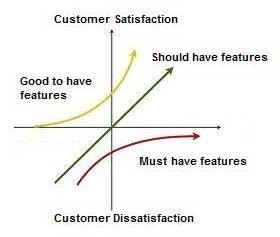Tremendous fluctuations in requirements, the heat of the market, competitiveness -- these are a few factors that arise during product development and force stakeholders to keep a continuous watch on the market and ask for quick changes as and when required. The Kano model helps Scrum product owners during product backlog refinement, in light of such changes and demands.
In Scrum, we welcome feedback and change requests from stakeholders, but it is important for a product owner to categorize and prioritize both change requests and the demand for inclusion of new features. At times the requests are just fancy tasks and do not contribute much value to business; hence they may be taken up later or could be discarded. On the other hand, some complex tasks provide good value to business and hence need to be taken up immediately. To get a grip on the flow of such requirements, the product owner needs to identify customer needs, analyze competitive products, analyze the value of such features, and -- based on all of that -- prioritize the product backlog items.
The Kano Model of Customer Satisfaction divides product attributes into three categories:

Let us take an example of a mobile phone.
Threshold attributes would be the ability to make outgoing calls and receive incoming calls, inclusion of a built-in camera, etc.
Performance attributes would be long battery life, a strong body, etc.
Excitement attributes would be assistive light, navigator apps, etc. These excitement attributes increase customer satisfaction, but their absence does not lead to dissatisfaction.
A challenge for a product owner is to manage the flow of multiple requirements coming from stakeholders and bring everyone to consensus about the requirements that provide the greatest value to business.
There are many approaches to limit the flow of requirements. A simple approach that's helpful for prioritizing the product backlog items is to ask stakeholders two simple questions for each attribute:
If you have more suggestions for product owners to help them manage and effectively prioritize the flow of requirements, please share your ideas
Originally published at Scrum Alliance web site- https://www.scrumalliance.org/community/articles/2015/january/product-backlog-refinement-and-prioritization-with
In Scrum, we welcome feedback and change requests from stakeholders, but it is important for a product owner to categorize and prioritize both change requests and the demand for inclusion of new features. At times the requests are just fancy tasks and do not contribute much value to business; hence they may be taken up later or could be discarded. On the other hand, some complex tasks provide good value to business and hence need to be taken up immediately. To get a grip on the flow of such requirements, the product owner needs to identify customer needs, analyze competitive products, analyze the value of such features, and -- based on all of that -- prioritize the product backlog items.
The Kano Model of Customer Satisfaction divides product attributes into three categories:
- Threshold attributes
- Performance attributes
- Excitement attributes

Let us take an example of a mobile phone.
Threshold attributes would be the ability to make outgoing calls and receive incoming calls, inclusion of a built-in camera, etc.
Performance attributes would be long battery life, a strong body, etc.
Excitement attributes would be assistive light, navigator apps, etc. These excitement attributes increase customer satisfaction, but their absence does not lead to dissatisfaction.
A challenge for a product owner is to manage the flow of multiple requirements coming from stakeholders and bring everyone to consensus about the requirements that provide the greatest value to business.
There are many approaches to limit the flow of requirements. A simple approach that's helpful for prioritizing the product backlog items is to ask stakeholders two simple questions for each attribute:
- Can you rate your satisfaction level, assuming the product has this attribute?
- Can you rate your dissatisfaction level, assuming the product does not have this attribute?
If you have more suggestions for product owners to help them manage and effectively prioritize the flow of requirements, please share your ideas
Originally published at Scrum Alliance web site- https://www.scrumalliance.org/community/articles/2015/january/product-backlog-refinement-and-prioritization-with